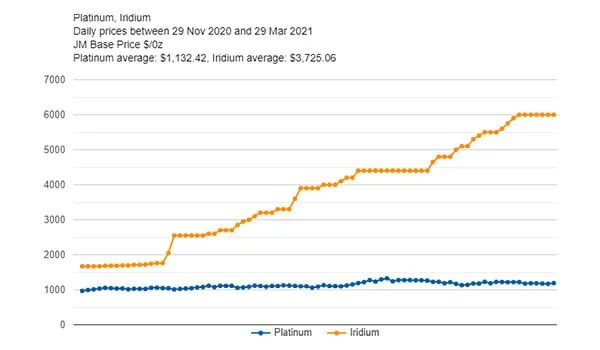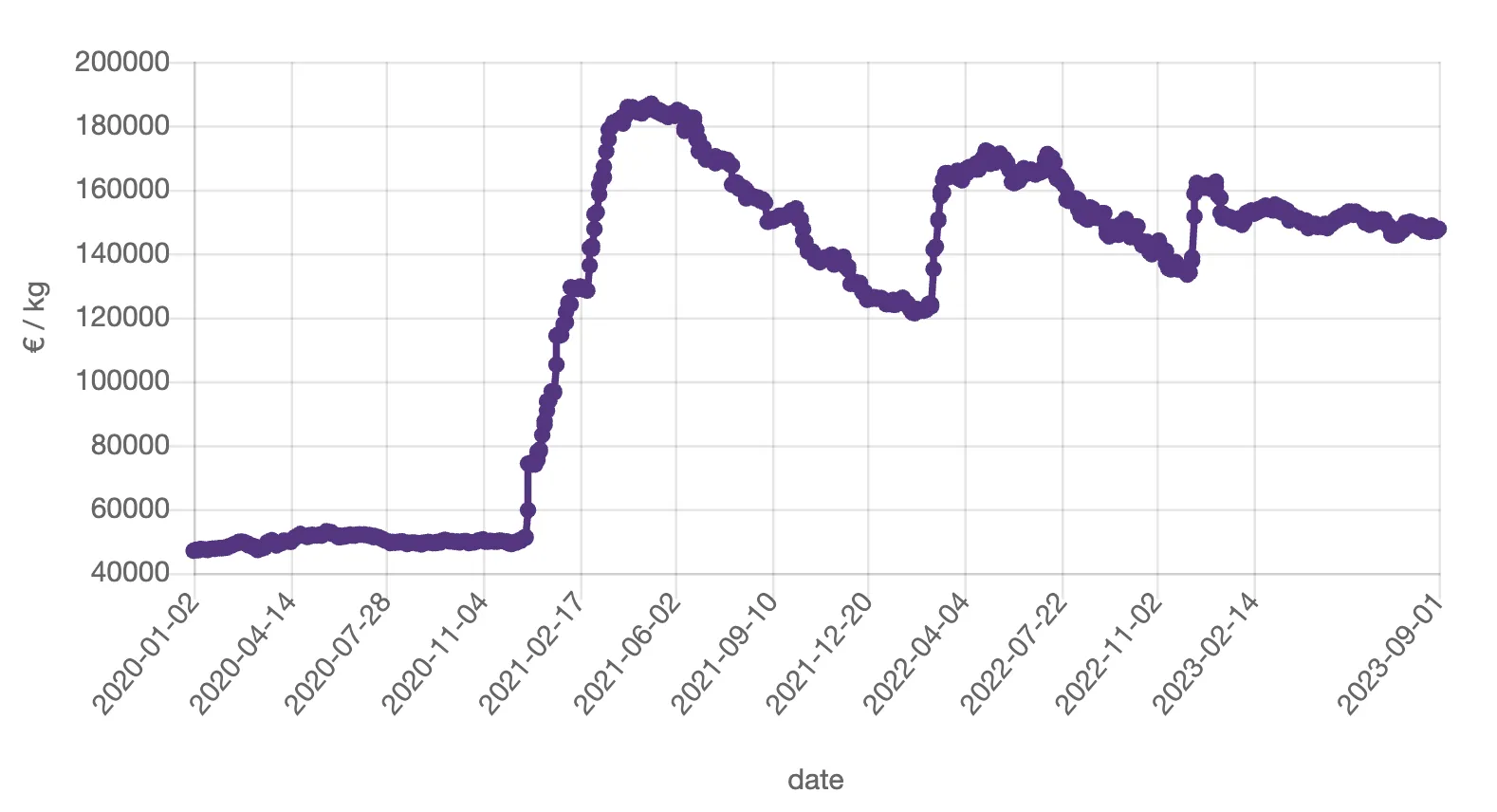This article is part of our series on metals and mining. You may also like our guide to investing in battery metals.
In recent years, iridium and Bitcoin have both experienced significant price fluctuations, albeit in different directions. In 2021, the price of iridium soared by 67%, outpacing Bitcoin's climb of 50%.

In 2016, Iridium was trading at around $500 an ounce, so it’s been a slow-burning riser for a few years.
Then, 2022, saw a divergence in Bitcoin and iridium's trajectories; iridium rose by 28% while Bitcoin took a steep fall, plummeting by -61%.
Fast forward to the first nine months of 2023, and iridium's price declined by 8%, whereas Bitcoin rebounded, climbing by 50%.
Although the two assets are unrelated, they are both considered alternative investments. This raises the question: Is iridium a metal worth investing in?
The sales chart of the iridium metal price in recent years makes interesting viewing. It appears largely flat, prior to 2020 but the price did rise from €28,150 per Kg in January 2013 to around €47,350 per Kg at the end of 2019.
During 2020 the price of iridium skyrocketed and continued until hitting a high of €186,850 per Kg in May 2021.

The price of iridium has since declined and soared twice more, reaching a lower high of €172,200 per Kg in April 2022 and €162,450 per Kg in January 2023.
How much is Iridium now? As of September 2023, it sits at a monthly average of €147,700 per Kg.
#What is Iridium?
Iridium is found in meteorites and in magma deep in the earth’s crust. But miners tend to come by it as a derivative of platinum and palladium mining. It’s a shiny metal that doesn’t oxidize in air and is harder than solid steel.
Iridium is number 77 in the Periodic Table. It’s a very hard, heavy, and rare metal. And its popularity is soaring. Why? You might ask, well this transition metal is forty times rarer than gold and is used in many industries. Spark plugs are one of its more popular uses.
The reason for iridium's price rise in recent years is because it is vital for many industries. It chlorinates ballast water in shipping, which stops vessels transporting aquatic creatures. According to Wikipedia, ballast water spreads approximately 7000 living species to new habitats around the planet. That disrupts ecosystems and puts species at risk of extinction.
Historically, Fountain pens were tipped with iridium, but that no longer seems to be the case.
Being much harder and stronger than platinum, with an extreme melting point, it’s a very useful element in creating spark plugs. In fact, iridium spark plugs are thought to last 25% longer than platinum spark plugs.
Iridium is also used in the crystal-making process because it can withstand extreme heat.
Best of all, it’s being used as a catalyst in electrolysis to split water into oxygen and hydrogen, which is gaining massive traction as the world pins its hopes on green hydrogen as a clean solution to climate change.
#A Corrosion Resistant Metal
Iridium holds the distinction of being the most corrosion-resistant metal known to science.
Its remarkable resistance to corrosion means that it is impervious to most chemical attacks, including those from strong acids. Even aqua regia, a potent mixture of nitric acid and hydrochloric acid capable of dissolving gold and platinum, fails to corrode iridium.
This exceptional property makes iridium highly valuable in a range of industrial applications where corrosion resistance is crucial. For example, it often finds use in the production of high-performance equipment exposed to extreme conditions, such as crucibles for melting other metals, and in the aerospace and automotive industries for components that must withstand high temperatures and corrosive environments.
The metal's corrosion resistance also contributes to its investment appeal, as it is less likely to degrade over time compared to other metals.
#How Much Is an Ounce of Iridium Worth?
To find out how much an ounce of iridium is worth today, you need to consider the current price per kilogram and then convert it to the price per ounce.
One ounce (oz) is approximately equal to 0.0283495 kilograms (kg).
Current Price in €/Kg: As of September 2023, the monthly average price of iridium is €147,700 per Kg.
Conversion Factor: There are approximately 35.274 ounces in a kilogram.
Price per Ounce: To find the price per ounce, you can use the formula:
Price per Ounce = Price per Kg/Ounces in a Kg
So, the calculation would be:
Price per Ounce = €147,700/35.274 ≈ €4,189.94
As of September 2023, an ounce of iridium is approximately worth €4,189.94.
#What Drives Iridium's Price Fluctuations?
Iridium's price fluctuations are influenced by a variety of factors, both supply and demand-side. Here's a breakdown:
Supply Factors:
Mining Output: Iridium is a byproduct of platinum and nickel mining. Any disruptions in these mining activities can affect the iridium supply.
Geopolitical Issues: Most iridium comes from South Africa and Russia. Political instability in these regions can impact supply.
Regulatory Changes: Environmental regulations can also affect mining activities, thereby influencing the supply of iridium.
Demand Factors:
Industrial Use: Iridium has several industrial applications, including in the automotive, electronics, and aerospace sectors. Increased demand in these industries can drive up prices.
Investment Demand: Like gold and other precious metals, iridium can act as a store of value. Investment demand can influence its price.
Technological Advancements: New technologies that require iridium can suddenly increase demand, affecting its price.
Market Sentiment:
Speculation: As with other commodities, speculative activities can lead to price volatility.
Economic Indicators: Global economic conditions can influence both supply and demand for iridium.
Currency Fluctuations:
Exchange Rates: Since the iridium cost is often priced in dollars or euros, changes in these currencies' value can affect its price.
#Are There Iridium Investment Opportunities?
If you're wondering how to invest in iridium metal, you may consider investing directly in the physical metal, although this comes with storage and insurance costs.
American Elements' AE Bullion™ group offers certified high-purity Iridium Bars designed for both short and long-term physical possession. These bars provide a way to gain exposure to the global iridium price and its industrial demand fluctuations.
In addition to bars, the company also offers iridium coins and ingots. These products are available for purchase by various entities, including funds, currency reserves, ETFs, private investors, collectors, and hobbyists, allowing them to take direct physical ownership of the metal.
Another approach is to invest in financial instruments like futures contracts that track the price of iridium.
However, one of the most direct ways to capitalize on iridium's potential is by investing in iridium mining companies.
#Iridium Mining Stocks
You may want to know how to invest in iridium. The stock market is an obvious starting point as there are a few metals and mining companies that deal in iridium.
As the metal is a byproduct of platinum and nickel mining, iridium investment usually involves investing in companies involved in these areas. Investing in iridium mining companies allows you to benefit from the entire value chain, from extraction to market sale.
#How Can Investors Get Exposure to Iridium?
The stronger demand outlook is based on expectations of an economic rebound, as well as anticipation that demand for hydrogen will increase the use of iridium.
Although the metal is useful, its market is fairly small. That means production amounts to approximately 250,000 ounces annually. Comparatively, palladium output is around 10 million ounces, and platinum is around 8 million. As it’s rare, it’s a by-product, rather than a focus on any miner’s portfolio, and raising production is not simple or quick.
Other platinum group metals (PGMs) have also experienced supply shortages and soaring prices. Rhodium and palladium are two. The market is illiquid which helps prices rise when supply is low.
Johnson Matthey
Johnson Matthey (LON: JMAT) is a refiner of PGMs and it is the number one recycler of PGMs including iridium, palladium, platinum, rhodium, and ruthenium.
PGM Services is Johnson Matthey’s refinery division. This supports its Clean Air division with the security of metal supply during volatile markets. PGM Services comprises PGM refining, recycling, and trading activities. It also produces chemical compounds and industrial products containing PGMs.
Impala Platinum
Impala Platinum (JSE: IMP) (OTC: IMPUY) is a South African miner that produces iridium as a by-product.
Implats operates as a leading, fully integrated producer of platinum group metals (PGMs). The company structures itself around six mining operations and Impala Refining Services (IRS), a refining business.
The company conducts its operations in key PGM-bearing ore bodies: the Bushveld Complex in South Africa, the Great Dyke in Zimbabwe, and the Canadian Shield. The company holds a primary listing on the JSE Limited in South Africa, a secondary listing on A2X, and runs a level 1 American Depositary Receipt program in the USA on the OTC.
Anglo American Platinum
Anglo American Platinum Ltd (OTC: AGPPF), stands as the world's leading primary producer of Platinum Group Metals (PGMs). The company offers a comprehensive resource-to-market service, supplying a global customer network with a variety of mined, recycled, and traded products.
Operating across the entire value chain, Anglo American Platinum produces a complete range of PGMs, including platinum, palladium, rhodium, iridium, ruthenium, and osmium.
The company dedicates different sites to each stage of production. High-profile applications for PGMs range from jewelry and auto-catalytic converters to air and water purification units and investment commodities.
#Other Materials Companies
Some other prominent players in the field of high-purity materials, include:
Umicore (OTC: UMICF): A global materials technology group headquartered in Belgium, focusing on recycling and the production of specialty materials.
BASF SE (OTC: BASFY): A German chemical company that also deals in precious and rare metals as part of its broader portfolio.
Heraeus: A German technology group with a focus on precious and special metals, medical technology, and other high-tech sectors.
Stanford Advanced Materials: This US-based company supplies over 5,000 advanced materials to leading industries like aerospace, technology, medical, and energy.
Goodfellow: A UK-based company that supplies a variety of metals and materials, including iridium, for research and industry.
Materion Corp (NYSE: MTRN): A U.S.-based advanced materials company that provides a range of high-performance metals and materials.
Alfa Aesar: A UK-based company specializing in research chemicals, metals, and materials, including rare earth elements like iridium. This company is owned by Thermo Fisher Scientific Inc (NYSE: TMO)
#Anglo American Platinum creates Iridium shortages
In November 2020, South African-based Anglo American Platinum Ltd (OTC: AGPPF), had to close its plant due to a series of water leaks. Unfortunately, this closure led to an iridium supply shortage, just as demand was growing.
An analyst at German technology group Heraeus said:
“Iridium has the longest processing time of all the PGMs, so supply is set to be impacted (by the Amplats closure) well into 2021, providing support for sustained high prices,”
South Africa produces 80-85% of the world’s iridium. This makes Anglo American Platinum a major producer. It also processes material for other miners, causing supply chain issues for several companies.
#Are There ETFs For Iridium Investment?
There are no specific Exchange-Traded Funds (ETFs) solely dedicated to iridium investment. Most investors interested in iridium typically explore other avenues, such as investing in physical iridium, futures contracts, or shares of mining companies that extract iridium as a byproduct of platinum or nickel mining.
However, there are broader precious metals or commodity ETFs that may include iridium as part of a diversified basket of assets. These ETFs often focus on a range of precious or industrial metals and may offer some exposure to iridium indirectly.
